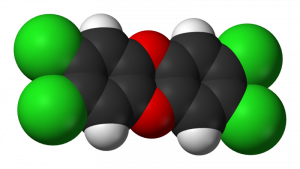
© Wikipedia CommonsA 3-d representation of a dioxin molecule
The U.S. Environmental Protection Agency is moving closer to its goal of releasing an updated estimate on the potential harm of dioxin exposure by the end of the year.
In May, in a long-stalled
response to concerns raised by the National Academies of Sciences in 2006, EPA reaffirmed its position that dioxin causes cancer and other negative health effects even at extremely low levels of exposure and stated that most Americans are being exposed to unsafe levels of the chemical through the foods that they eat.
Stephen Lester, science director for the
Center for Health Environment and Justice is in the process of reviewing EPA's 1,850 page document .
"EPA is standing behind its analysis that shows dioxin causes adverse health hazards at very low levels," Lester said. "
We would say it is a serious public health hazard."
"Food is the primary means of exposure for the general public," he said, and "
roughly 90 percent of general population is exposed to dioxin through food, primarily beef and dairy."
For the first time in this report EPA has named a level of dioxin exposure at which no adverse health effect is expected to be observed, Lester said, but this level is so low that it indicates that most Americans are already receiving more than is safe.
EPA's actions on dioxin are of particular importance in Michigan, which is home to the headquarters of the Dow Chemical company. Operations at Dow's Midland facility have resulted in dioxin contamination of the city of Midland and of a 52 mile long stretch of the Saginaw River watershed.
New understandings on the health effects of dioxin could affect the type of cleanup that happens in this area and the type of assistance offered to those living in the contaminated zone.
According to
Peter deFur, an environmental consultant who specializes in human health risk assessment, EPA's latest report assigns dioxin a carcinogenicity factor that is about 7 times higher than before.
If this assessment is finalized it would mean that the agency would require more dioxin to be removed during cleanups.
The American Chemical Council, an industry-funded trade group, sought to downplay EPA's latest dioxin report. In a statement the group said that EPA's reference dose relied on "questionable research" and that the agency's work "exaggerates health effects expected from normal dietary exposure." ACC did not respond to a request for more information.
People who are living on the dioxin-contaminated soils downstream from Dow's Midland plant risk exposure to the chemical through contact with the soil, and the state has issued advisories warning people to restrict their gardening activities and outdoor play and to severely curtail consumption of local fish and game.
A recent study by the University of Michigan Dioxin Exposure Study warned that no crops for human consumption should be raised on dioxin-contaminated soil such as the Tittabawassee floodplain.For residents of the contaminated area, reducing overall dietary dioxin exposure could be an important way to minimize the health risks associated with dioxin.
In its recent publication EPA recommends that people reduce their dioxin exposure by lowering their consumption of animal fats through using less butter and lard, choosing lower fat cuts of meat and by using cooking methods such as oven broiling that reduce fat.
The agency also stresses that people who fish should check for fish consumption advisories, especially in areas where water contamination is known to have occurred.
The known, quantifiable industrial emissions of dioxin have been reduced by more the 90% from their levels in the 1980's, according to the EPA, and the open burning of household trash is now thought to be the largest source of dioxin emissions to the environment.
Dioxin is a persistent pollution, however, and emissions from long ago still pose an exposure risk.
The dioxin from plants and smokestacks falls out onto grazing land and is consumed by livestock which absorb it into their fat where it concentrates over time.
Because dioxin fallout follows wind patterns, contamination can accumulate in areas far away from industrial development.
A study by Barry Commoner of Queen's College in New York, for example, found that
emissions from Midwest garbage incinerators end up in native people that live in the Arctic Circle.In an effort to reduce ongoing dioxin pollution, the Michigan Department of Natural Resources and Environment has proposed banning the open burning of trash and is currently accepting comments on that idea.
Lester said that CHEJ is hoping EPA will follow through on its commitment to finalize and release its dioxin reassessment this year.
"The American public needs to understand this information," Lester said, "and until the reassessment is finalized that won't happen."
EPA notes that its recent response to the National Academy of Sciences is a draft scientific document that is still subject to independent external peer review and public review.
Reader Comments
to our Newsletter